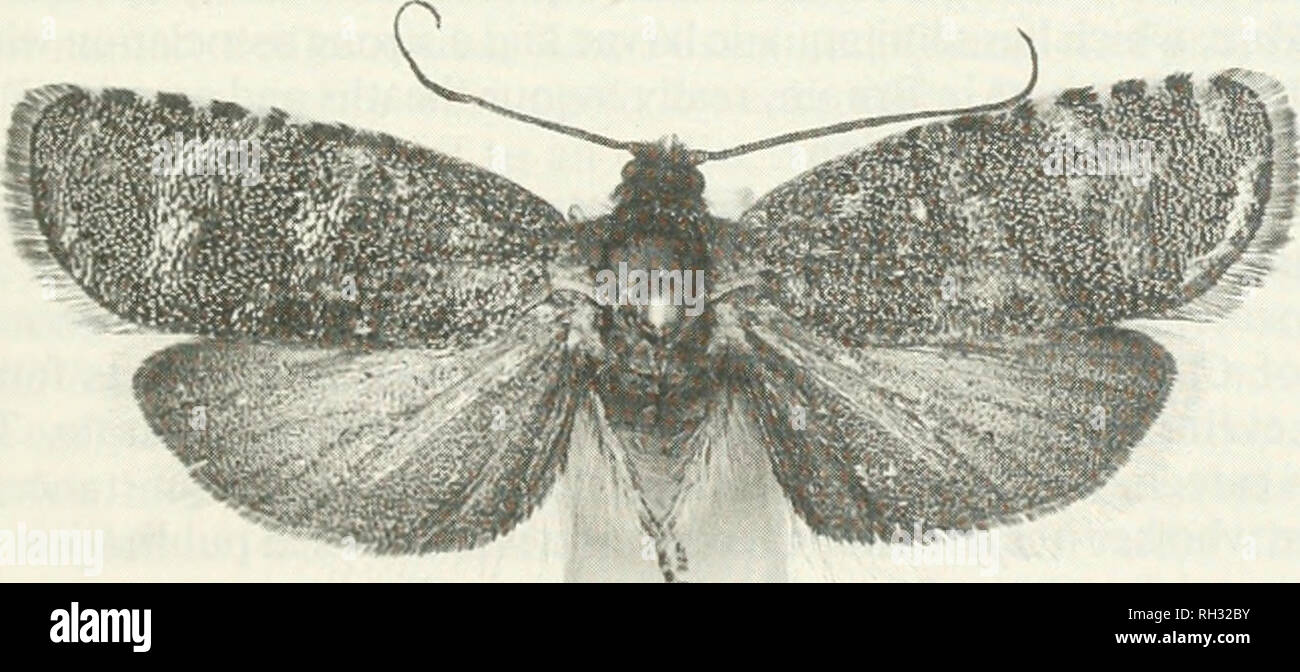. British journal of entomology and natural history. Natural history; Entomology. BR. J. ENT. NAT. HIST., 7: 1993 1 A RECORD OF CYDIA INJECT/VA (HEINRICH) (LEPIDOPTERA: TORTRICIDAE) FROM NORTH ABERDEENSHIRE K. R. Tuck The Natural History Museum, Cromwell Road, London SW7 5BD AND M. R. Young University of Aberdeen, Tillydrone Avenue, Aberdeen AB9 2TN. In December 1992 Mr Michael Innes found two live adults of a tortricid moth in his home in Peterhead, North Aberdeenshire (vice-county 93). He collected one of these and subsequently it was identified at The Natural History Museum, London, as bein

Image details
Contributor:
Library Book Collection / Alamy Stock PhotoImage ID:
RH32BYFile size:
7.1 MB (378.5 KB Compressed download)Releases:
Model - no | Property - noDo I need a release?Dimensions:
2361 x 1058 px | 40 x 17.9 cm | 15.7 x 7.1 inches | 150dpiMore information:
This image is a public domain image, which means either that copyright has expired in the image or the copyright holder has waived their copyright. Alamy charges you a fee for access to the high resolution copy of the image.
This image could have imperfections as it’s either historical or reportage.
. British journal of entomology and natural history. Natural history; Entomology. BR. J. ENT. NAT. HIST., 7: 1993 1 A RECORD OF CYDIA INJECT/VA (HEINRICH) (LEPIDOPTERA: TORTRICIDAE) FROM NORTH ABERDEENSHIRE K. R. Tuck The Natural History Museum, Cromwell Road, London SW7 5BD AND M. R. Young University of Aberdeen, Tillydrone Avenue, Aberdeen AB9 2TN. In December 1992 Mr Michael Innes found two live adults of a tortricid moth in his home in Peterhead, North Aberdeenshire (vice-county 93). He collected one of these and subsequently it was identified at The Natural History Museum, London, as being a North American species, C. injectiva. According to Heinrich (1926) the larva of this species feeds in cones of Pinus species, particularly P. jeffreyi, and has been recorded from California, Oregon and North Carolina. A search for the origin of Mr Innes's specimens revealed that his wife had acquired, as decorations, a number of large pine cones from a friend who had recently visited America. One of these cones had several obvious cocoons between its scales and one of the cocoons had pupal exuviae projecting from it. The cone was submitted for identification to Dr Ian Brown, University of Aberdeen, and proved to be from Pinus jeffreyi. Unfortunately none of the other cocoons produced moths, but there seems little doubt that these were the source of Mr Innes's specimens. C injectiva (Fig. 1) has a wingspan of 15-17 mm. It is a dark greyish brown species with two prominent paler metallic bands across its forewing and is thus unlikely to be mistaken for any British species of Cydia. A closely related Nearctic species, C piperana (Kearfott), has an identical biology (Heinrich, 1926) and might also be imported accidentally with pine cones. It is slightly larger than C. injectiva and has a more pointed apex to the forewing. The pale bands across its forewing are narrower than in C. injectiva and contrast more strongly with the ground-colour of the wing. Following display of the s